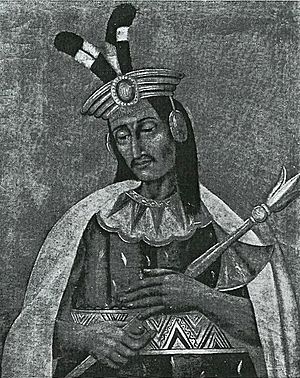Huáscar facts for kids
Quick facts for kids Huáscar |
|
|---|---|
 |
|
| Sapa Inca of the Inca Empire | |
| Reign | 1527–1532 |
| Predecessor | Huayna Capac Ninan Cuyochi (only a few days) |
| Successor | Atahualpa |
| Born | 1491 Huascarpata, Peru |
| Died | 1532 (aged 40–41) Cusco, Peru |
| Spouse | Chuqui Huipa |
| Issue | Leonor Curicuillor |
| Dynasty | Hanan Qusqu |
| Father | Huayna Capac |
Huáscar Inca (/ˈwɑːskɑːr/; Quechua: Waskar Inka; 1503–1532) was a powerful leader of the Inca Empire. He was known as the Sapa Inca, which means "the only Inca" or "emperor." He ruled from 1527 until 1532. Huáscar became emperor after his father, Huayna Capac, and his brother, Ninan Cuyochi, both died from a disease called smallpox.
Contents
Huáscar: The Inca Emperor
The name Huáscar has a couple of interesting stories behind it. One idea is that he was named after a huge gold chain. This chain was made to celebrate his birth. In the Quechua language, "Huasca" means "chain." His father thought "chain" wasn't a good name for a prince. So, he added an "r" to make it "Huáscar." Another story says his name came from his birthplace, Huascarpata.
Becoming the Sapa Inca
How Huáscar became the Sapa Inca is a bit unclear. There were different groups of people who wanted different leaders. Also, the Spanish writers who wrote about this time often got their information from the winners of the civil war. This means their stories might not be completely fair.
Originally, Huayna Capac, Huáscar's father, chose his infant son Ninan Cuyochi to be the next emperor. But Ninan Cuyochi died very quickly. After that, there was a discussion about who should rule next. Some say Huayna Capac chose Huáscar's half-brother, Atahualpa, who then said no. Others say Huáscar was chosen directly. No matter the exact details, Huáscar became emperor. He was supported by a group in the city of Cusco.
The Inca Civil War
Huáscar's rule was not peaceful. There was a big disagreement over who should be emperor. This led to a civil war between Huáscar and his half-brother, Atahualpa. Atahualpa was supported by leaders in the northern part of the empire.
One Spanish writer, Juan de Betanzos, wrote about Huáscar's rule. He described Huáscar as being a bit unfair. However, Betanzos's account might be biased. This is because his wife had been married to Atahualpa before. Betanzos wrote that Huáscar took over lands that belonged to previous dead Inca emperors. These lands were important for honoring the past leaders. He also took lands set aside for the worship of the Sun god. This showed that Huáscar did not respect traditional Inca religion.
Huáscar then declared war on Atahualpa. The battles were very large, with armies of tens of thousands of soldiers fighting. Huáscar was eventually defeated in two major battles: the Battle of Chimborazo and the Battle of Quipaipán. After these defeats, Huáscar was captured. Atahualpa's commanders, Quizquiz and Chalicuchima, took control of Cusco.
The Arrival of the Spanish
The civil war was still happening when the Spanish explorer Francisco Pizarro arrived in the Inca Empire. Atahualpa was winning the war at this point. The ongoing conflict actually helped Pizarro. First, the Inca armies were tired and weakened from fighting each other. Second, the empire was divided. Some people in Cusco, who were loyal to Huáscar, even celebrated when Atahualpa was captured by the Spanish.
Later, Atahualpa had Huáscar killed. Atahualpa worried that Huáscar might offer Pizarro more gold for his own freedom. Atahualpa wanted to be the only one to negotiate with the Spanish. He said he would give more gold than Huáscar if Huáscar was removed.
See also
 In Spanish: Huáscar para niños
In Spanish: Huáscar para niños
- Huascarán, highest peak in Peru and named for Huáscar

